-
Paper Information
- Previous Paper
- Paper Submission
-
Journal Information
- About This Journal
- Editorial Board
- Current Issue
- Archive
- Author Guidelines
- Contact Us
Resources and Environment
p-ISSN: 2163-2618 e-ISSN: 2163-2634
2013; 3(1): 10-13
doi:10.5923/j.re.20130301.02
Towards Assessment of Saudi Arabia Public Awareness of Water Shortage Problem
Omar K M Ouda
Department of Civil Engineering, Prince Mohamed Bin Fahd University, Al Khobar, Kingdom of Saudi Arabia
Correspondence to: Omar K M Ouda , Department of Civil Engineering, Prince Mohamed Bin Fahd University, Al Khobar, Kingdom of Saudi Arabia.
| Email: |  |
Copyright © 2012 Scientific & Academic Publishing. All Rights Reserved.
Kingdom of Saudi Arabia (KSA) is located in a very harsh natural desert environment with no rivers or lakes and an average yearly rainfall of less than 100 mm. The country is under extreme water shortage conditions. To meet the ever increasing water demand, KSA currently produces around 1 Billion Cubic Meter of desalinated sea water per year with an average cost of 0.80 US $/ m3. The current water pricing system does not meet this cost. The water supplied to public almost free, where an average Saudi family pays less than 2 US $ per month for water. The current investigation was designed and implemented to measure the public awareness of water shortage problem and their wiliness to pay for water. One hundred and ninety-six questionnaires were completed online and in person in Al Khobar City at the Eastern Province of KSA. Results from the survey show low-level of water shortage awareness among respondents. Extensive work is urgently needed to increase water awareness through water media campaigns. It shows also that the majority of respondents believe that they do not pay much for water. The current water pricing system should go through an intensive review and should be considered as an economic incentives tool for water conservation.
Keywords: Saudi Arabia Water Resources, Water Shortage, Public Awareness, Water Pricing System
Cite this paper: Omar K M Ouda , Towards Assessment of Saudi Arabia Public Awareness of Water Shortage Problem, Resources and Environment, Vol. 3 No. 1, 2013, pp. 10-13. doi: 10.5923/j.re.20130301.02.
Article Outline
1. Introduction
- The Kingdom of Saudi Arabia (KSA) has an area of about 2.25 million km2 with a total population of about 30 million. During the last three decades, the kingdom has experienced comprehensive development in all sectors coupled with high growth rates in population and living standards. This resulted in ever increasing water consumption in the agricultural, municipal and industrial sectors. In 2005, the average water share per capita was 282 Cubic Meter per year. According to the scarcity index, the country is under extreme water shortage condition[1]. As a result, water demand management and water conservation including efficient water pricing system are no longer just concepts in KSA. They should become fundamental aspects in the management of a valued yet stressed resource. The starting point is to identify the public awareness level of water shortage problem and their wiliness and ability to pay for water.
1.1. Water Resources
- KSA falls in very harsh natural desert environment with no rivers or lakes and average yearly rainfall of less than 100 mm[2, 3, 4]. KSA utilizes conventional (natural) and unconventional water resources to satisfy the ever increasing water demand. The conventional water resources include surface water and groundwater. Surface water consists of seasonal runoff flowing Wadis during the months of November and April[2]. The runoff water ranges from 2 to 2.4 Billon Cubic Meter (Billion m3) per year mostly exists in the southwest and coastal area where rainfall is reasonably abundant and regular[2]. Runoff water is captured in 260 dams collecting an estimated 0.6 Billion m3 per year[5]. Groundwater system consists of shallow aquifer and deep aquifer. The shallow contains renewable water supply recharged by rainfall infiltration. The deep aquifer is confined with very limited recharge rate. The aquifer contains brackish groundwater with total dissolved solid concentration over 1000 Parts per Million (ppm)[2]. The KSA total renewable conventional water resources are about 6 Billion m3 per year[4]. The nonconventional water resources include desalination of sea water and treated wastewater. The Saline Water Conversion Corporation operates 30 water desalination plants located in the East Coast (Arabian Gulf) and the West Coast (Red Sea) of KSA[6]. The desalination stations produce more than 1 Billion m3 per year, which forms about 26% of world total production of sea water desalination[5, 7]. Over the next five years, new desalination plants will be built by private water and power producers to add extra 1 Billion m3 per year to current production rate[6]. The 2010 desalinated water production cost was 0.80 United States Dollar per cubic meter (0.80 US $/ m3)[7]. The total production rate of wastewater treatment plant is about 730 Million m3 per year[6] of which, 44 Million m3 per year is used for roads landscape irrigation across the country[6].
1.2. Water Consumption
- KSA total water consumption is about 24 Billon m3 per year. The agriculture sector is the largest consumer accounting for 88% of total consumption. The industrial sector consumes 3%[5, 8]. The municipal sector consumers about 9% and has been estimated at 2.1 Billon m3 per year[5]. The average municipal water consumption was around 260 litres per capita per day[9, 10]. The desalination plants covered about 35% of the industrial and municipal water consumptions while the remaining 65% from groundwater sources. High population growth rate 3% per annum coupled with rural migration to urban centres resulted in annual growth rate of municipal water consumption of 4.3% between the years 1999 to 2004[5, 6]. This growth rate is expected to continue unless strong water demand management measures are implemented including sustainable water pricing system.
1.3. Water Pricing System
- Table 1 below shows the current municipal water price in KSA. An Average Saudi family of 5 persons pays less than 2 US $ per month for water. This water is mainly comes from desalination plants that cost on average of 40 US $ to produce in addition to an average of 40 US $ to transport to the end users. As a conclusion, the water is almost free. The current KSA water price is highly subsidized by the KSA government and is totally unsustainable where a major enhancement is extremely needed.
|
2. Survey Design and Distribution
- Questionnaire survey is a scientifically approved method to gather public feedback and to measure public awareness in water issues. Questionnaire survey was designed and distributed to residents of Al Khobar City in the Eastern Province of Saudi Arabia. Al Khobar is a middle size city with a population of about 250 thousand consisting of both Saudi Citizens and International Expats. The municipal water consumption in Al Khobar City is about 400 litre per capita per day which is much higher than the KSA national average. The survey distribution goal was to collect as much feedback from public as possible. The survey was distributed to Al Khobar City residents using two methods: online and in person. The survey was made available online (surveymonkey.com). A digital link was made available to the public and university employees through e-mail distribution. The same survey was conducted in person at a university campus, two shopping malls, three hospitals, and various construction sites to ensure diversity of respondents. The survey started on April 28th, 2012 and continued for three weeks. Out of total 197 questionnaires completed, 157 were in person and 42 received online.
3. Results and Analysis
- Microsoft excel was used for survey analysis and interpretation. The survey questions were designed in multiple choice formats, where respondent selects the answer that meets his point of view. The questions were divided into two main groups to measure the public awareness of the water shortage problem in KSA and their wiliness to pay for water.
3.1. Public Awareness of Water Shortage
- The survey respondents were asked about the main sources of water in KSA. As shown in Figure 1, the Majority of respondents (57%) believed desalination plants are the main source. This is far away from reality while desalination plants provided only about 5% of total water demand and about 35% of municipal and industrial water supply.
 | Figure 1. Result of the question: what are the sources of water in KSA |
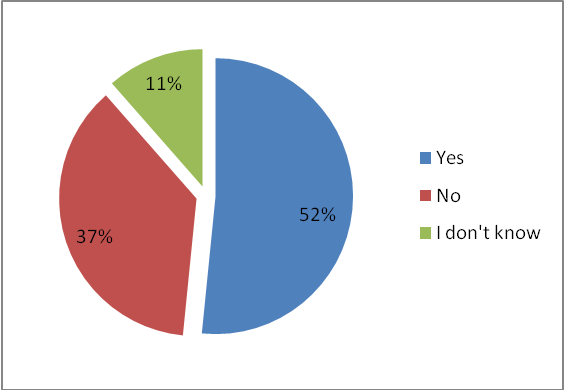 | Figure 2. Results of the question: Do you think KSA has a water shortage problem |
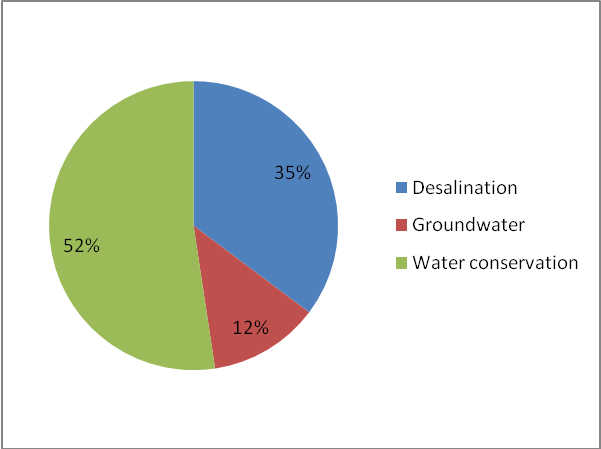 | Figure 3. Results of the question: what is the best solution for the shortage problem |
3.2. Public Wiliness to Pay
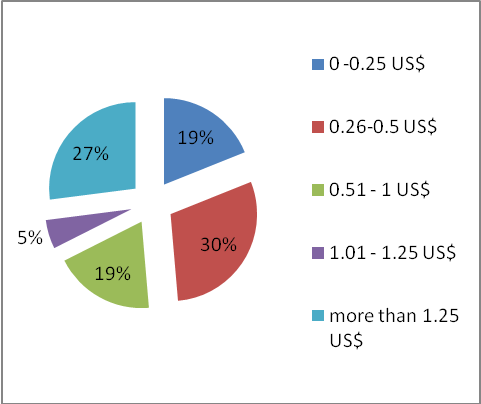 | Figure 4. Results of the question: How much is the production cost of cubic meter of desalinated sea water |
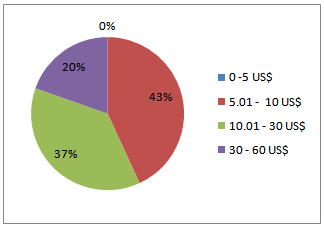 | Figure 5. Results of the question: How much is your average monthly water bill |
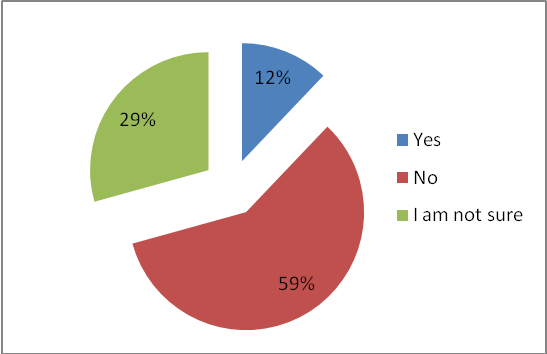 | Figure 6. Results of the question: Do you think you pay a lot of money for water per month |
4. Conclusions and Recommendations
- KSA is facing a chronic water shortage problem. To achieve sustainable level of water consumption, technical measures should be coupled with non-technical measures including public awareness campaigns and objectively water pricing system. The survey results show a low level of public awareness of the water shortage problem in KSA. Extensive work is urgently needed to increase water awareness through water media campaigns. This may include campaigns through radio, newspapers, and TV and school programs to explain the current water resources and water consumption practice and potential improvement. Information about water desalination cost and how to participate in efforts in conserving water or using water more efficiently should also be included. Water pricing system should be designed as economic instrument to set awards for water conservations. The existing water pricing system does not meet this goal. The majority of the survey respondents believe that they do not pay much for water. The current water pricing system should go through an intensive review. The research findings shall be considered as preliminary investigation results, where further work is need towards detailed delineation of the water awareness campaigns structure and water pricing system.
ACKNOWLEDGEMENTS
- The author is thankful to Ahamed Shawesh, Tareq Al-Olabi and Firas Younes senior students at the Civil Engineering Department, Prince Mohamed Fahd University for the help in conducting the questionnaire survey as part of their senior level project.
 Abstract
Abstract Reference
Reference Full-Text PDF
Full-Text PDF Full-text HTML
Full-text HTML